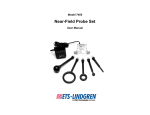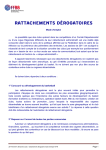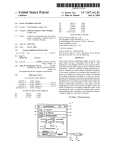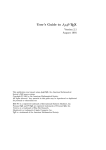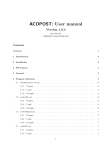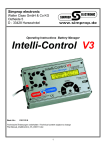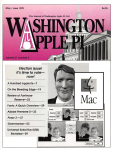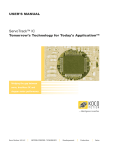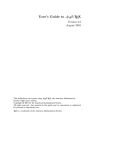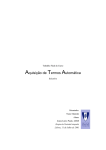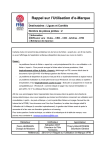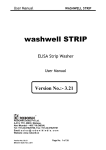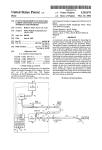Download Chapter 2
Transcript
The formalism and environment of Constraint Grammar Parsing
Fred Karlsson
(Published as Chapter 2 in Fred Karlsson, Atro Voutilainen, Juha Heikkilä and Arto Anttila, eds., Constraint
Grammar: A Language-Independent Framework for Parsing Unrestricted Text. Mouton de Gruyter, Berlin /
New York 1995, 41-88)
1.
Outline
This is a full documentation of the Constraint Grammar Parser CGP. The emphasis is on
describing how a Constraint Grammar for a particular language is designed and developed. The
general motivation, aims, and properties of Constraint Grammar Parsing were expounded in
Chapter 1 (also cf. Karlsson 1989, 1990). Here, in Chapter 2, all aspects of the parsing formalism
are treated. A full survey is given of the details that need to be known for properly applying
Constraint Grammar to a language, and for running the parser once a description of a language is
available.
The basic purpose of this chapter is thus to act as a user's manual. Most of the
examples in this and the subsequent chapters will be drawn from the English Constraint Grammar
description (ENGCG) done within the framework of the ESPRIT-II project “Structured
Information Management, Processing, and Retrieval” (SIMPR).
One of the aims of Constraint Grammar Parsing is to make it possible to parse
unrestricted text. It is important to have a clear view of the sequencing of the whole parsing
process, especially of what modules precede Constraint Grammar Parsing proper. Full-scale
optimal Constraint Grammar Parsing proceeds by application of five consecutive modules:
INPUT: raw ASCII text
MODULE FUNCTION
(1) preprocessing which includes i.a. case conversion, sentence delimiter specification,
and treatment of fixed syntagms,
(2) lexicon updating, for spotting new words not included in the relevant Master
Lexicon (which contains the core vocabulary of the language), and inserting them in
one or more domain-specific lexicons to be used in conjunction with the Master
Lexicon during morphological analysis,
(3) morphological analysis which provides all word form tokens with their morphological
readings, one or more,
(4) local morphological disambiguation: some morphological ambiguities arising due to
compound formation may be discarded by mere local inspection of the configuration
of readings derived for one word-form, without paying attention to contextual factors.
Local disambiguation is relevant especially in languages such as Finnish, German, and
Swedish, where productive processes of compound formation tend to overgenerate
even if due care is taken in order to minimise such overgeneration, cf. Chapter 1 and
especially Karlsson (1992) for examples,
(5) Constraint Grammar Parsing,
OUTPUT: morphologically and syntactically analyzed text.
The main aim of Constraint Grammar Parsing is thus to perform surface-syntactic analysis of
morphologically analyzed unrestricted text. More precisely, the Constraint Grammar Parser
performs three basic types of operations on sentences consisting of morphologically analyzed
word-forms having single or multiple readings (interpretations).
The first operation is context-sensitive disambiguation performed by disambiguation
constraints. The second is assignment of clause boundaries in complex sentences performed by
clause boundary mappings. The third is assignment of surface-syntactic functions, i.e.
grammatical labels such as finite main verb, subject, or genitival premodifier to a noun. This is
performed by syntactic rules of which there are two types: morphosyntactic mappings and
syntactic constraints proper.
A full-fledged Constraint Grammar (CG) of a language contains rules of all these
types. Such a grammar has been developed for English and its documentation is indeed the
purpose of the subsequent chapters.
Clause boundary mapping, context-sensitive morphological disambiguation, and
syntactic function assignment interact. Optimally they should be conceptually viewed, and
computationally implemented, as parallel submodules, all executable simultaneously. In the
present Lisp, C, and C++ implementations of the Constraint Grammar interpreter, they have been
related to each other as partly repeatable, sequential steps in the following way, found out to be
optimal by way of empirical experimentation. This is how Constraint Grammar Parsing works
internally by default:
STEP
(1)
(2a)
(2b)
(3a)
(3b)
(4)
(5)
FUNCTION
clause boundary mapping
context-sensitive disambiguation
clause boundary mapping
context-sensitive disambiguation
clause boundary mapping
morphosyntactic mapping
syntactic analysis
First (1) as many intrasentential clause boundaries as possible are inferred and marked (i.e.
mapped) in the morphological input. Some clause boundaries are introduced already in the
lexicon(s), such as those inherent in subjunctions like if, when, and relative pronouns such as
which, whose.
Then (2a) the first round of context-sensitive disambiguation applies, followed by one
more round (2b) of clause boundary mapping, since more boundaries can be spotted due to
disambiguation effects. Then comes (3a,b) one more round of morphological disambiguation and
clause boundary mapping. Optionally it is possible to suppress (3a,b), or to have even three more
rounds like (3a,b).
Next (4), all remaining readings get their potential surface-syntactic labels (if not
lexically supplied) via the application of morphosyntactic mapping statements. Then syntactic
constraints apply (5). Maximally five passes of syntactic analysis can be invoked: syntactic
constraints may feed each other by creating contexts favourable for the application of other
constraints. Steps (4,5) may be omitted if plain morphological disambiguation is to be exercised.
In actual practice, it is left to the discretion of the Constraint Grammar writer to
experiment and determine precisely how many rounds of morphological disambiguation and
syntactic analysis is optimal for the task at hand. Maximally five rounds may be invoked both in
morphology and syntax.
For some tasks it can be helpful to invoke manual disambiguation mode. This
requires the user to disambiguate all cohorts that context-sensitive disambiguation does not
manage to resolve. Manual disambiguation is thus interleaved with context-sensitive
disambiguation.
A further central idea is to combine the benefits of a grammar-based and a heuristic
approach to parsing. Specifically, there are five types of heuristic tools, all of them of course
optional: (i) morphological heuristics, i.e. rules for predicting morphological readings for wordforms that were not given one or more analyses by the morphological analyzer; (ii) heuristic
disambiguation constraints and heuristic syntactic constraints, invoked when ordinary constraints
no longer apply; (iii) text-based heuristics which is a possibility of letting disambiguation
decisions once made affect later decisions concerning the same words in the same text, e.g. if the
N/V-ambiguous word-form hit has been disambiguated as N, certain instances of this word-form
in later sentences are also disambiguated as N; (iv) purely quantitative heuristics, i.e. decisions
can be made on the basis of pure probabilities (if the requisite quantitative data are available); (v)
deactivation heuristics, a possibility of dismissing consideration of disambiguation constraints for
certain structures by enforcing a simplified solution on all instances, e.g. all imperatives may be
discarded if they are judged not to be feasible alternatives in the present text.
There is an intricate interplay between ordinary constraints and heuristic tools.
Morphological heuristics and deactivation heuristics work prior to any ordinary constraints. The
other heuristic tools apply after the ordinary constraints but in partial interplay with them. In
particular, the ordinary disambiguation constraints will be retried after every single application of
a heuristic disambiguation constraint. Similarly, the ordinary syntactic constraints are retried
every time a heuristic syntactic constraint applies. The maximum Constraint Grammar Parsing
set-up is thus:
(a)
(b)
(c)
(d)
(e)
(f)
(g)
(h)
(i)
(j)
(k)
morphological analysis
morphological heuristics
deactivation heuristics
clause boundary mapping
context-sensitive disambiguation (maximally five rounds, each followed by clause
boundary mapping; optionally interleaved with manual disambiguation)
heuristic disambiguation
text-based disambiguation
quantitative disambiguation
morphosyntactic mapping
syntactic analysis (maximally five rounds)
heuristic syntactic analysis
The basic use of Constraint Grammar is as a general-purpose parsing tool. But the Constraint
Grammar Parser can also be used as a tool for corpus work on texts parsed by a Constraint
Grammar, viz. for excerpting sentences that contain instances of a structure specified by the user.
The structure may be defined using word-forms and all morphological features and syntactic
labels available in the analyzed text file. The Constraint Grammar Parser also provides several
facilities for testing and debugging candidate constraints.
The Constraint Grammar Parser, viewed as a computer program, is an interpreter
taking two main inputs. One major input is a constraint file containing disambiguation constraints,
clause boundary mappings, and surface-syntactic rules, plus the requisite declarations needed for
defining the proper contexts of the constraints. The second major input is a text file containing
sentences that consist of morphologically analyzed word-form tokens. An important aim of
Constraint Grammar Parsing is that it should be able to cope with ordinary unrestricted text.
The output of Constraint Grammar Parsing is a text file which is an enriched subset
of the input text file. It is enriched because surface syntactic functions (labels) have been added to
the word-forms. It is a subset because those morphological readings and syntactic functions have
been discarded that the constraints forbid.
All kernel and environmental functionalities of Constraint Grammar Parsing as
described in this chapter have been implemented in standard Common Lisp by the present author.
By kernel functionality is here meant the constraint formalism and the basic principles for
interpreting constraints. The environmental functionalities comprise various tools for error
detection and error diagnosis, debugging, optimization, constraint testing and tracing, internal
consistency checks, determination of functional load (such as frequency counts), and on-line help
and documentation. These are very important aids in the course of the time-consuming and
laborious task of constructing a truly corpus-based Constraint Grammar.
The Common Lisp implementation is presently available as a Constraint Grammar
interpreter on Unix workstations under Lucid Common Lisp and Allegro Common Lisp. Under
Lisp, the full system, including preprocessing, morphological analysis, and all subcomponents of
Constraint Grammar syntactic parsing, utilizing an English constraint grammar containing some
1,500 morphological and syntactic constraints, presently runs on a Sun SPARCstation 2 at a
speed of 3B4 words per second.
Two production versions of the Constraint Grammar Parser are also available. The
first one was programmed in C++ by Bart Jongejan of CRI A/S, Copenhagen. It incorporates the
Constraint Grammar Parsing kernel but not all of the environmental aid. This version reads the
same input files as the Common Lisp version, and yields the same output. Presently it works at
15B20 words per second, i.e. roughly six times faster than the Lisp version. The second
production version, programmed in C by Pasi Tapanainen (Research Unit for Computational
Linguistics, University of Helsinki), and reading the same input files, does full syntactic analysis at
a speed of 400-500 words per second on a Sun SPARCstation 10/30. This figure clearly shows
that efficient surface-syntactic analysis is possible.
2.
Input text file requirements
The text file fed to the Constraint Grammar Parser consists of morphologically analyzed wordform tokens. A word-form with its readings (interpretations) forms a cohort, e.g.:
(“<stress>”
(“stress” <SVO> <SVOO> V SUBJUNCTIVE VFIN (@+FMAINV))
(“stress” <SVO> <SVOO> V IMP VFIN (@+FMAINV))
(“stress” <SVO> <SVOO> V INF)
(“stress” <SVO> <SVOO> V PRES -SG3 VFIN (@+FMAINV))
(“stress” N NOM SG))
The morphological readings are assigned by TWOL-based morphological analyzers (Koskenniemi
1983). TWOL should run in Lisp mode yielding parenthesized cohorts where the first element is
the word-form (enclosed in double quotes and angular brackets), and the other elements (sublists)
are its readings. TWOL should also run in base-form mode, outputting as first element of each
reading its base form, enclosed in double quotes. All word-forms should ordinarily have
morphological readings, one if the word is morphologically unambiguous and several if the word
is ambiguous. The word-form stress above is five-ways ambiguous. The function of the angular
brackets is to separate word-forms (with brackets) from base forms (without brackets). More
specifically, an input text file should look like this:
(”*metrical”
(”metrical” <*> <DER:ic> <DER:al> A ABS))
(”accent”
(”accent” <SVO> V SUBJUNCTIVE VFIN (@+FMAINV))
(”accent” <SVO> V IMP VFIN (@+FMAINV))
(”accent” <SVO> V INF)
(”accent” <SVO> V PRES -SG3 VFIN (@+FMAINV))
(”accent” N NOM SG))
(”is”
(”be” <SV> <SVC/N> <SVC/A> V PRES SG3 VFIN))
(”the”
(”the” <Def> DET CENTRAL ART SG/PL (@DN>)))
(”stress”
(”stress” <SVO> <SVOO> V SUBJUNCTIVE VFIN (@+FMAINV))
(”stress” <SVO> <SVOO> V IMP VFIN (@+FMAINV))
(”stress” <SVO> <SVOO> V INF)
(”stress” <SVO> <SVOO> V PRES -SG3 VFIN (@+FMAINV))
(”stress” N NOM SG))
(”pattern”
(”pattern” <SVO> <Rare> V IMP VFIN (@+FMAINV))
(”pattern” <SVO> <Rare> V INF)
(”pattern” N NOM SG))
(”established”
(”establish” <SVO> <SVOO> PCP2)
(”establish” <SVO> <SVOO> V PAST VFIN (@+FMAINV)))
(”by”
(”by” PREP)
(”by” ADV (@ADVL)))
(”the”
(”the” <Def> DET CENTRAL ART SG/PL (@DN>)))
(”meter”
(”meter” <SVO> <Rare> V IMP VFIN (@+FMAINV))
(”meter” <SVO> <Rare> V INF)
(”meter” N NOM SG))
(”$.”)
Base-forms are spelt out in lower case in the lexicon, with an asterisk indicating upper case of the
next letter, where needed. The lexical forms of Bill, NATO, WordPerfect are thus *bill,
*n*a*t*o, *word*perfect.
Following the base-form, a reading may contain any morphological features
postulated in the description of the language. Depending upon how elaborate the lexicon and the
constraints are, there may also be one or more lexically assigned syntactic labels, enclosed in a
final sublist. Each syntactic code should be prefixed by the designated character ”@”, e.g. @CC
(coordinating conjunction), @+FMAINV (finite main verb).
Syntactic labels are provided in the lexicon for all items that have few syntactic
functions, optimally just one. Thus, the indefinite article a has its only syntactic label @DN>
(normally, determiner of the next head nominal to the right) given in the lexicon, as have all finite
verb forms (IMP, PRES, PAST, etc.) which get the code @+FMAINV. Recall the basic maxim
of Constraint Grammar Parsing: do as much as possible as early as possible. Because syntax, just
as morphological disambiguation, relies on elimination of alternatives, it is advantageous to
introduce all simple syntactic instantiations at once. Readings not having syntactic labels after
morphological analysis get them via morphosyntactic mapping.
If quantitative heuristics is used (cf. section 15), readings may also contain numbers
expressing probabilities of occurrence, e.g. (”that” 2.34 <**CLB> CS).
One mandatory preprocessing step is to convert original asterisks, ”*”, in the input
text to some other character. In Two-level Morphological Analysis and Constraint Grammar
Parsing, the asterisk has the designated function of expressing upper case of the following lowercase letter. All input word-forms to TWOL and CGP should be in lower case.
The Constraint Grammar Parser operates on sentence-like chunks bounded by
designated sentence delimiters such as ”$.” declared in the constraint file. The sentence delimiters
are separated from their word bodies during preprocessing. Besides the sentence delimiters, all
other non-letter and non-digit characters are also treated as individual words. They are thus
dissociated from their word bodies by the preprocessor and prefixed by the character ”$”, the
general function of which is to indicate the start of a non-word element. These characters have
the following appearance after morphological analysis:
”$,” ”$'” ”$"” ”$/” ”$(” ”$)” ”$=” ”$B” ”$_” ”$&”
“$&” actually is an entry in the ENGTWOL lexicon. Several others are given features by
ENGTWOL. These features may be referred to by the constraints just as if they were features of
ordinary word-forms. These characters frequently provide useful hints about syntactic position
and function of the neighbouring words. All constraints should capitalize on all information that is
available.
The preprocessing module collapses certain fixed expressions into quasi-word-forms
the parts of which are glued together. In phrasal idioms and multi-word prepositions the juncture
character “=” is used, in compounds the understroke character “_”, e.g.
because=of, in=spite=of, tea_time.
The Constraint Grammar Parser is meant to be robust in demanding applications
where the input texts might be marked up according to conventions such as those of
Standardized General Markup Language (SGML) for the purpose of indicating document
structure (headings, captions, footnotes, etc.). If such codes are in use, they should be individual
tokens on their own lines and prefixed by the ”$”-character, e.g. (from the SIMPR project):
$STARTBIB $STARTCAPTION $STARTCAPCODE $STARTFOOTNOTE $STARTHEAD
$STARTHCODE $STARTIDIOM $STARTSUBSEC $STARTSUBSECHEAD $STARTTEXT
$STARTDOC $STARTDOCHEAD $STARTTITLE
(plus the same starting with $END)
Whenever needed, intrasentential clause boundaries should be marked by the symbol ”**CLB”. If
emanating from the lexicon, this symbol is enclosed in angular brackets:
(”that”
(”that” <**CLB> CS))
(”which”
(”which” <Rel> <**CLB> PRON))
**CLB indicates intrasentential clause boundaries and is used in clause boundary mode by
constraints that must not apply across a potential clause boundary. The lexicon should be
designed so that clause boundary features are present where needed.
The second source of the feature **CLB is via clause boundary mapping. Here, the
feature is added to a reading immediately after the base form and without angular brackets, e.g.
to a coordinating conjunction found before a finite verb:
(”and”
(”and” **CLB CC (@CC)))
3.
The constraint file
The constraint file consists of thirteen sections. The following designated expressions must occur
in the following form and order, each followed by sets, function declarations, constraints etc. of
the appropriate type:
SENTENCE-DELIMITERS
SET-DECLARATIONS
SYNTACTIC-FUNCTION-DECLARATIONS
PRINCIPAL-FUNCTION-DECLARATIONS
TEMPLATES
MORPHOSYNTACTIC-MAPPINGS
CLAUSE-BOUNDARY-CONSTRAINTS
DISAMBIGUATION-CONSTRAINTS
HEURISTIC-DISAMBIGUATION-CONSTRAINTS
SYNTACTIC-CONSTRAINTS
HEURISTIC-SYNTACTIC-CONSTRAINTS
MORPHOLOGICAL-HEURISTICS
TEXT-BASED-HEURISTICS
END
Every reasonable constraint file contains some set(s) and non-heuristic constraint(s). Comment
lines are prefixed by the character ”;”. Next, all subparts of a constraint file are described in
detail. When the file is read by the Lisp version of the Constraint Grammar Parser, extensive
checks are performed for ensuring that the file is syntactically in order. If needed, error reports
are issued and the parser enters a break.
4.
Sentence delimiters
The Constraint Grammar Parser operates on sentences, i.e. chunks bounded by designated
sentence delimiters. These must be declared after the word SENTENCE-DELIMITERS, as a list
containing the requested delimiters (at least one), each prefixed by the characer “$” and enclosed
in double quotes and angular brackets, e.g. (the typical delimiter set):
SENTENCE-DELIMITERS
(”<$.>” ”<$!>” ”<$?>”)
”<$:>” and ”<$;>” are potential sentence delimiters, depending upon the task at hand. The
periods, colons, etc. of the input text should be preprocessed in order to have the above
appearance. The double quotes and angular brackets are inserted by the morphological analyzer.
Several sentence delimiters are multifunctional. For example, the period “.” might occur medially
in abbreviations. Distinguishing such uses from the sentence-delimiting ones is one task of the
preprocessor. Texts also contain composite sentence delimiters like ”..”, ”Y”, ”!!”, ”!!!”, ”??”,
”!?”. These should either be included in the delimiter declaration as ”<$..>”, ”<$...>”, etc., or
normalized during preprocessing.
The comma may be added to the delimiter set also by providing a special argument to
the Constraint Grammar Parser call (cf. section 18). This simulates clause analysis in a crude way
(the comma is multifunctional). Clause boundary mappings assign the feature **CLB to those
instances of a comma that can be inferred to delineate intrasentential clauses.
5.
Set declarations
After the word SET-DECLARATIONS, all sets of grammatical properties are declared that the
constraints need for the purpose of generalization. Each set declaration is a list bounded by
parentheses consisting of a set name (a Lisp symbol) followed by one or more set elements.
Primitive set elements may be any component of a reading, i.e. (i) base forms such as
”car”, ”come”, ”that”, ”who”; (ii) angle-bracketed features such as <SVOO>, <Rare>; (iii) part
of speech labels such as A (adjective), N (noun), C (conjunction); (iv) morphological features
such as NOM (nominative), PL (plural), SG3 (3rd person singular), IMP (imperative); and (v)
syntactic labels such as @SUBJ (subject of the main verb), @+FAUXV (finite auxiliary). Base
forms are (Lisp) strings enclosed in double quotes, the other elements are (Lisp) symbols.
Primitive set elements are disjunctive alternatives, i.e. the set is instantiated as soon as one
primitive is found in a reading. The set declaration (PREMOD A DET) thus declares the set
PREMOD (short for ”premodifier”) which is instantiated as soon as either A or DET in found.
Sets may also have sublists, each containing one or more primitive elements. Sublist
primitives are conjunctively related, i.e. every such primitive must occur in a reading if that sublist
is to be instantiated. The set (ADV-WH (ADV WH)) is thus instantiated in readings containing
both ADV and WH. The internal order of the elements declared as members of such lists does
not matter. Thus the following two sets are equivalent:
(ADV-WH (ADV WH))
(ADV-WH (WH ADV))
If a set contains both sublists and top-level primitive elements, all sublists precede all primitives,
e.g.:
(AAD/QUANT/THAT (”that” CS) A ADV <Quant>).
Sets, i.e. set names, are used in context conditions of constraints. The Constraint Grammar Parser
matches set primitives and sublist primitives against the features of readings when constraints are
evaluated, i.e. occurrence of primitives is either required or prohibited. Thus, given a cohort such
as:
(”a”
(”a” <Def> DET CENTRAL ART SG/PL (@DN>)))
all of the elements ”a”, <Def>, DET, CENTRAL, ART, SG/PL, @DN> are potential candidates
for occurring in sets. Some real examples:
SET-DECLARATIONS
(>>> >>>)
(<<< <<<)
(N N)
(CS CS)
(CS-THAT (”that” <**CLB> CS))
(PREMOD A DET)
(NEG-V (PRES NEG) (IMP NEG))
(VFIN PRES PAST IMP SUBJUNCTIVE)
(TO-V ”to” V)
(<SVO> <SVO>)
(@SUBJ @SUBJ)
(@SUBJ/OBJ @SUBJ @OBJ)
The sets >>> and <<< refer to sentence-initial and sentence-final position, respectively, and must
always be declared. The brackets of angular-bracketed features should be present, e.g. (<SVO>
<SVO>). Syntactic labels such as @SUBJ may occur as set members if three conditions are
satisfied: all set members are syntactic labels, they are declared as syntactic functions (see section
6), and the set name is prefixed by the character ”@”.
For reasons of perspicuity, the Constraint Grammar Parser does not allow syntactic
labels to be intermixed with morphological features and base forms in the same set. If a constraint
contains subcontexts referring both to morphology and syntax, these should be expressed in
separate sets, and referred to by different individual context conditions, e.g.:
…(0 @SUBJ) (1 VFIN)…
…(1 CS-THAT) (2 @SUBJ) (3 VFIN)…
Use of syntactic @-sets can be risky in morphological disambiguation if morphosyntactic
mapping has not yet been performed. During morphosyntactic mapping, syntactic sets are safely
available only left of the word currently being mapped. These restrictions are consequences of the
fact that Constraint Grammar modules are applied in sequential order (cf. section 1).
Furthermore, the constraints of an individual module such as morphosyntactic mapping are
applied to the words of the sentence from left to right.
Set names and primitives should preferably not contain any of the following
characters. If used, they should be prefixed by the backslash character ”\”:
.,;:”#'`()[]
6.
Syntactic function declarations
After the word SYNTACTIC-FUNCTION-DECLARATIONS, a list must be declared of all
syntactic labels (functions, codes) used in the syntactic description, i.e. in morphosyntactic
mappings or syntactic constraints proper. The labels are expressed as symbols prefixed by the
character ”@”:
SYNTACTIC-FUNCTION-DECLARATIONS
(@+FMAINV @-FMAINV @+FAUXV @-FAUXV @SUBJ @OBJ @PCOMPL-S
@PCOMPL-O @GN> @QN> @<NOM @<P)
Arrows on modifier labels, “>” or ”<”, indicate in what direction the respective head is to be
found. If no morphosyntactic mappings or syntactic constraints are postulated, the syntactic
function declaration list may be omitted or represented as NIL.
7.
Principal function declarations
After the word PRINCIPAL-FUNCTION-DECLARATIONS, two lists can be declared. The first
contains the principal syntactic functions, i.e. those syntactic labels that are subject to the
Uniqueness Principle. These may occur maximally once in a simplex clause containing no
coordination. (This list is a subset of the labels declared under
SYNTACTIC-FUNCTION-DECLARATIONS.)
PRINCIPAL-FUNCTION-DECLARATIONS
(@+FAUXV @+FMAINV @SUBJ @OBJ @PCOMPL-S)
In Constraint Grammar syntactic analysis, morphosyntactic mapping and certain syntactic
constraints are based on the Uniqueness Principle. Each simplex clause is checked for eventual
violations of the principle whereupon many superfluous syntactic labels may be discarded. For
example, given that a morphologically unambiguous reading of a cohort in clause c contains an
unambiguous syntactic label @SUBJ, a syntactic constraint may discard ambiguous instances of
@SUBJ occurring elsewhere in c, e.g. in a reading that has been assigned the syntactic labels
(@SUBJ @OBJ), both rightwards and leftwards of the unique @SUBJ as long as no clause
boundaries are crossed. The Uniqueness Principle is invoked after every morphosyntactic
mapping and after every application of a syntactic constraint involving a principal syntactic
function.
Syntactic pruning based on the Uniqueness Principle relies on proper determination
of clause boundaries. If these are not in order, too many syntactic labels are likely to be pruned.
The second list under PRINCIPAL-FUNCTION-DECLARATIONS contains those features that
constitute non-transcendable boundaries. Uniqueness-based pruning, spreading left and right, is
limited by the occurrence of such barrier elements. Typical barriers include the comma, clause
boundaries marked by **CLB, finite verbs, participles as predicates in nonfinite constructions,
coordinating conjunctions, and subjunctions.
PRINCIPAL-FUNCTION-DECLARATIONS
(@+FAUXV @+FMAINV @SUBJ @OBJ @PCOMPL-S)
(COMMA **CLB <**CLB> VFIN PCP1 PCP2 CC CS)
Both these lists may be omitted or represented as NIL. However, the first list cannot be omitted
(it must be represented as NIL) if the second list is to be specified.
8.
Morphosyntactic mappings
After the designated word MORPHOSYNTACTIC-MAPPINGS, the mapping relations between
morphological features and syntactic labels are established. The mappings assign one or more
syntactic labels to each morphological reading remaining after context-sensitive disambiguation if
such labels are not already present due to lexical description. Labels are lexically assigned
whenever they are (next to) unique. However, nothing prevents declaration of all mappings in the
lexicon. Then no mappings are needed in the constraint file. Each mapping is expressed as a list
containing three sublists:
< target, context condition(s), syntactic label(s) >
The target is a list containing one or more of the morphological elements capable of occurring in
readings, i.e. angle-bracketed, part-of-speech, or other morphological features, or base forms,
e.g. (N), (PRON), (N NOM SG), (V PAST), (V PRES -SG3), (”much”). The internal order of
the elements does not matter. Word-forms such as ”much” are not allowed in targets of
morphosyntactic mappings. Neither can mappings contain a set name as target.
The Constraint Grammar Parser organizes mappings in packets according to the first
element of the target. Thus, (N) and (N NOM SG) belong to the packet N; (V), (V PAST), (V
PRES -SG3) belong to the packet V, etc.
When applying mapping statements, the Constraint Grammar Parser invokes the
principle of application order in two ways. First, within each packet, the mappings are tested in
the order they appear in the constraint file. Second, when a morphological reading is scanned in
search for applicable mappings (= packets), the Constraint Grammar Parser puts hits (= packet
names) on an agenda in the order they are found. Thus, if there are mapping packets for PRON
and GEN, and given the reading (”it” PRON GEN SG) for the word-form ”its”, the Constraint
Grammar Parser will first test the mappings for PRON (in the order they were in the file), then
the mappings for GEN.
Due care must be exercised when mappings are formulated, especially in regard to
what element in a multi-element target is put first. This decides what packet the respective
mapping belongs to. For example, if one wants the reading in the cohort below to be mapped via
the N packet with mention of both N and <Proper> in the target, the correct target formulation is
(N <Proper>). If the target is formulated (<Proper> N), the mapping will belong to the <Proper>
packet.
("<Bill>"
(”bill” <*> <Proper> N NOM SG))
The label(s) is a list with one or more syntactic labels that the target may have. The legal labels
are declared under SYNTACTIC-FUNCTION-DECLARATIONS. Every morphological feature
does not need individual mapping. Every reading should be mapped onto some syntactic label(s).
Mappings can often be restricted, given contextual knowledge. For example, in our
syntactic interpretation an English noun has maximally twelve syntactic labels. But if it occurs in
sentence-final position and the preceding word is a preposition, the noun must be a complement
of that preposition. Mappings have as their second element a set of context conditions (cf. section
9.2). In mapping statements, the context conditions are expressed as a list of sublists, each
context condition making up its own sublist, e.g.:
((N) ((-1C PREP) (1 <<<)) (@<P))
which assigns a target noun (N) the unique syntactic label ”prepositional complement” (@<P) if
the noun occurs in final position, i.e. the next cohort contains the sentence-boundary marker (1
<<<), and the preceding word (-1) with certainty (C) is a preposition (PREP).
Default mappings concern the worst case when the maximal set of syntactic labels is
assigned to a reading. No context conditions are needed:
((N) NIL (@SUBJ @OBJ @I-OBJ @PCOMPL-S @PCOMPL-O ...))
Mappings with specific context conditions should be listed before the more general cases. Last
comes the default (elsewhere) mapping without context conditions (NIL). Here are four packets
of somewhat simplified mappings for the nominative case:
MORPHOSYNTACTIC-MAPPINGS
((N NOM) ((1 N)) (@NN>))
((NOM) ((-1 PREP)) (@<P))
((NOM) ((-2 PREP) (-1 DET/A/GEN/WORTH)) (@<P))
((NOM) ((-1 VFININF)) (@OBJ))
((NOM) ((1 VFIN) (NOT 1 COP) (NOT *-1 @SUBJ)) (@SUBJ))
((NOM) ((-1 COP) (*-2 @SUBJ)) (@PCOMPL-S))
((NOM) ((NOT *-1 COP)) (@SUBJ @OBJ @I-OBJ @APP @NN> @<P))
((NOM) NIL (@SUBJ @OBJ @I-OBJ @PCOMPL-S @PCOMPL-O @APP @NN> @<P))
((PRON NOM) ((NOT *-1 COP)) (@SUBJ @OBJ @I-OBJ @<P))
((PRON NOM) NIL (@SUBJ @OBJ @I-OBJ @PCOMPL-S @PCOMPL-O @<P))
((”there”) ((1 ADV) (2 VFIN)) (@F-SUBJ))
The PRON packet (including the PRON NOM target) is tested before the NOM packet because
part of speech labels occur left of cases in readings. For nouns, the first test is whether the next
word is a noun. If so, the label assigned is premodifier (@NN>). If not, the next test is whether
the previous word is a preposition. If it is, the label @<P is assigned, etc.
One more special restriction obtains. Because mapping proceeds sequentially from
left to right for the words in a sentence, mapped syntactic labels are dependably available only
leftwards of any word currently being mapped, in positions such as -1, -2, *-1. In mappings,
context conditions with rightwards positions such as 1, 2, *1 must therefore not refer to sets
containing syntactic functions such as (@SUBJ @OBJ). Mappings are not obligatory. They may
be omitted or represented as NIL.
9.
Disambiguation constraints
All essential properties of the constraint formalism are the same for disambiguation constraints,
syntactic constraints, and clause boundary mappings. The formalism is presented here with the
disambiguation constraints as the prime example. Disambiguation constraints are listed after the
designated word DISAMBIGUATION-CONSTRAINTS, and they are expressed as lists
bounded by parentheses. However, disambiguation constraints are not obligatory. They might be
omitted or represented as NIL.
A constraint contains four obligatory constituents: domain, operator, target, and
context conditions(s), plus an optional clause boundary mode indicator. Next, all of these will be
treated in detail.
9.1.
Domain, target, and operators
There are two types of domain defining an item to be disambiguated. The first is a particular
word-form such as that or who. As TWOL output, the representation of word-forms is e.g.
”that” and ”who”, i.e. a word-form is expressed as a string bounded by angular brackets and
double quotes. The second type of domain is the designated domain @w which is a dummy
variable over any word-form possessing the features specified in the target.
The target defines which reading(s) the constraint is about, among the readings
present in the cohort that the domain specifies. The target may be a list of one or more features
such as (V), (V PRES), (V PRES -SG3), picking one or more readings each of which should
have all the features of the target. Base forms such as ”run” may occur as members of targets but
only in non-first position of the target list. Thus, (V ”run”), (V PRES ”run”), and (V ”run”
PRES) are legal targets, but not (”run”) or (”run” V).
Second, the target can be a declared set symbol such as VFIN (introducing the set
members PRES, PAST, IMP, SUBJUNCTIVE) that picks all readings possessing at least one of
the features listed in the set. The target defines position 0, the center of the system of positional
specifications used in context conditions.
An operator defines which operation to perform on the reading(s) picked by the
target in a domain. Three operators are in use, here presented in order of decreasing strength:
=!!
picks the target reading as correct and discards all other readings if the context
conditions are satisfied; the target reading itself is discarded if the context conditions
are not satisfied.
=!
picks the target reading as correct and discards the other readings if all context
conditions are satisfied.
=0
discards the target reading if the context conditions are satisfied (but retains all other
readings).
9.2.
Context conditions
The context conditions are defined relative to the target reading which is in position 0. Position 1
is one word to the right of the target, position -3 three words to the left of the target, etc.
Normally, a context condition is a triple:
<polarity, position, set>
Polarity is expressed either by the element NOT (negative) or nothing (positive). Position is a
position number, and set a declared set name.
An asterisk ”*” prefixed to position number n refers to a position rightwards of n (if
n is positive), or leftwards of n (if n is negative), in both cases including n, up to the final and
initial sentence boundaries, respectively. Such conditions are unbounded and their positions are
called *-positions, e.g. *2 (two or more words rightwards from the target), *-1 (one or more
words leftwards from the target). Unbounded constraints cater for long-distance phenomena.
Three examples:
CONTEXT
CONDITIONS
MEANING
(1 N)
a reading with the feature N is expected in the cohort of the next word
(NOT *-1 VFIN
)nowhere leftwards is there a reading with any of the feature combinations
declared under VFIN
(1 PREMOD)
(2 N)
(3 VFIN)
readings are expected with the features A or DET in position 1, with
N in position 2, and with one of the VFIN feature specifications in
position 3
Position numbers may also contain the suffixed letter ”C” (e.g. 1C, -2C, *-3C) inducing careful
application mode (9.5). Here are two typical disambiguation constraints for English (the set
declarations of section 4 are presupposed):
(@w =0 VFIN (-1 TO))
(”for” =! (CS) (NOT -1 VFIN) (1 TO) (2 INF) (*3 VFIN))
The first one discards finite verb readings if the preceding word has a reading with the base form
”to”. The second states that the subjunction reading (CS) of the word-form ”for” is correct if the
preceding word is not a finite verb, if the base form of the next word is ”to”, if the word after this
is an infinitive, and if there is a finite verb in or rightwards of position 3.
Position numbers, positive or negative, used in normal Constraint Grammar practice
do not exceed 7. Sensible constraints utilize close contexts (e.g. 1, -3) or are unbounded (e.g. *1,
*-2) starting in the vicinity of position 0. For efficiency reasons, the current implementation of the
Constraint Grammar Parser works within a 50-word window extending 25 words left and right of
position 0. Testing of context conditions is terminated at positions -25 and 25 (inclusive). If the
condition then remains not satisfied, a test looking for a positive result return ”false”, and a test
looking for a negative result returns ”true”. There is a possibility of leaks if a sentence is longer
than 25 words and testing of unbounded constraints is terminated at window limits. However,
few problems with this practice have been encountered.
When several context conditions refer to the same position, e.g. (1 N) (1 NOM), the
constraint is satisfied only if all conditions are true of at least one and the same reading. The two
conditions in conjunction are thus satisfied by reading (a) below but not by the ensemble of
readings (b,c):
(a) … N NOM SG …
(b) … N GEN SG …
(c) … A NOM SG …
Negative context conditions are evaluated before positive ones. Further testing of a constraint is
suspended if a negative condition such as (NOT 1 N) is violated. Else, context conditions are
tested in the order they appear in the constraint.
Context conditions with position 0, e.g. (0 N), can refer to all readings of the target
cohort. One may thus impose further conditions either on the target reading itself, or on some
other (just one) reading of the target word. The latter possibility is useful in situations where a
certain reading is to be discarded by a ”=0”-operation only if the target word has another reading
complying with the ”0”-condition(s). It is not possible to have ”0”-conditions refer
simultaneously both to the target reading and to other readings of the same word. The use of
position 0 in careful mode, 0C, is not needed and therefore disallowed. By definition, careful
mode is applicable only to cohorts containing at least two readings distinct in regard to the
respective target.
When a constraint contains both ordinary and unbounded context conditions, it is
recommendable to write the ordinary conditions before the unbounded ones, i.e. rather:
… (1 N) (*-1 VFIN) …
than the other way around. If the first test, (1 N), fails, there is no need to test the more costly
unbounded condition. A test to this effect is enforced anyway at input time when the constraint
file is being read. Internally to the Constraint Grammar Parser, bounded conditions thus precede
unbounded ones.
When a sentence is read at input, its final delimiter, e.g. ”$.”, is appended as a feature
to the sentence end boundary ”<<” which thus has a reading like (<<< ”$.”) The delimiter is
useful in context conditions, e.g. ”$!” could resolve an initial verbal ambiguity as imperative.
Given a set declaration such as (<$!> ”$!”), the presence of ”$!” can be tested by the context
condition (*1 <$!>).
9.3.
Normal and careful application mode
Disambiguation constraints discard readings in the contexts of readings of other words. But the
context words may themselves be ambiguous. For any context condition, the option is available
of taking the risk to disambiguate in an ambiguous context, which we call normal application
mode, or of allowing a context condition to be satisfied only in unambiguous contexts (careful
application mode). In careful mode, the character C, short for ”careful”, is appended to the
position number. Normal and careful mode may be mixed in the same constraint. Examples:
(1C N)
(*-1C VFIN)
(1C PREMOD) (2C N) (3C VFIN)
(1 PREMOD) (2C N) (3C VFIN)
In one situation, an ambiguous cohort satisfies a context condition formulated in careful mode,
viz. when two or more readings all comply with the requirement. All readings pass the test (1C
VFIN) in this cohort:
(”stress”
(”stress” <SVO> <SVOO> V SUBJUNCTIVE VFIN (@+FMAINV))
(”stress” <SVO> <SVOO> V IMP VFIN (@+FMAINV))
(”stress” <SVO> <SVOO> V PRES -SG3 VFIN (@+FMAINV)))
All context conditions of all constraints may be globally required to apply in careful mode by
giving a properly formulated fourth argument when the Constraint Grammar Parser is started (see
section 18). Negative context conditions should not be required to apply in careful mode, e.g.
(NOT 1C VFIN). It suffices to determine whether the negative constraint is satisfied.
9.4.
Absolute and relative positions
Absolute positions are indicated by plain positive (1, 3) or plain negative integers (-1, -4), and
unbounded positions by starred integers such as *1, *-2. The origo of the position specification is
always the absolute position of the target. Unbounded positions are instantiated at individual
absolute positions. Thus, the unbounded position *1 may be instantiated at any position 1, 2, 3, Y
,25 (cf. section 9.3).
Relative positions refer to absolute or unbounded positions right or left of the
absolute position of an instantiated ”*”-position. If (*2 PREP) is instantiated at absolute position
4, further references in relation to the target might be needed to positions relative to 4, e.g.
immediately to the left (absolute position 3), somewhere to the right (unbounded position *5), 4
itself (0), etc. Relative positions are linked to the preceding context condition which must contain
either a ”*”-position or another relative position. The link is provided by a pair of identical hooks,
one occurring at the end of the regent ”*”-condition, the other as the (relative) position
specification of the dependent context condition, e.g.:
… (*2 VFIN R+1) (R+1 N) …
where R+1 refers to the position immediately to the right of the absolute position where *2 is
instantiated. The following relative positions are available (R = right, L = left):
R+1
R+1C
R+2
R+2C
R+3
R+3C
R+4
R+4C
*R
*RC
L-1
L-1C
L-2
L-2C
L-3
L-3C
L-4
L-4C
*L
*LC
LR0
next position to the right
as above, careful mode
two words to the right
as above, careful mode
three words to the right
as above, careful mode
four words to the right
as above, careful mode
some position to the right
as above, careful mode
next position to the left
as above, careful mode
two words to the left
as above, careful mode
three words to the left
as above, careful mode
four words to the left
as above, careful mode
some position to the left
as above, careful mode
the regent itself
By way of example, if the regent position *1 is instantiated at absolute position 3, and another
regent position *-1 at absolute position -4, then:
MEANING OF
R+1
R+1C
L-1
L-1C
*R
*RC
*L
*LC
LR0
IF p = 3
4
4C
2
2C
4,5,6, …
4C,5C,6C, …
2,1
2C,1C
3
IF p = -4
-3
-3C
-5
-5C
-3,-2,-1
-3C,-2C,-1C
-5,-6,-7, …
-5C,-6C,-7C, …
-4
The directional interpretation of R and L depend upon whether the absolute regent position is
positive or negative. In both cases, R means rightwards and L leftwards. If the regent is positive
(e.g. 3), rightwards means away from the target (4, 5, …), and leftwards means towards target
(2, 1). If the regent is negative (e.g. -4), rightwards means towards the target (-3, -2, -1), and
leftwards means away from the target (-5, -6, …). When relative positions are checked towards
the target (which is in position 0), the last positions to be checked are 1 and -1. The relevant span
is between the absolute regent position and target position 0.
If further context conditions are to be checked on the other side of position 0, they
should utilize ordinary absolute (not relative) positions. It is thus not possible to refer beyond
position 0 by relative positions, e.g. from regent position -4 to dependent position 2. Dependent
conditions may also be negated, e.g.:
… (*1 VFIN R+1) (NOT R+1 N) …
Several dependent positions may be linked to each other, e.g.:
… (*1 VFIN R+1) (R+1 A R+1) (R+1 N) …
which has the meaning ”somewhere to the right there is a finite verb that is immediately followed
by an adjective that is immediately followed by a noun”. The context condition (R+1 A R+1) is a
dependent of the condition (*1 VFIN R+1) and a regent of the condition (R+1 N).
It is not practical to define relative positions after negative regents. Therefore, a
context condition pair such as the following one is illegal:
… (NOT *-1 VFIN R+1) (R+1 N) …
9.5.
Clause boundary application mode
Some constraints or constraint combinations must not apply across clause boundaries. Clause
boundary application mode is enforced by having either of the symbols **CLB (non-careful
mode) or **CLB-C (careful mode) appear as the last element of the constraint. Clause boundary
mode is most practical in connection with unbounded constraints:
(@w =! VFIN (NOT *-1 VFIN) (NOT *1 VFIN) **CLB-C)
stating that a verbal finite reading is correct if there are no finite readings in the span from the
target to the next clause boundary, leftwards and rightwards. Clause boundaries are indicated by
the presence of either of the symbols **CLB or <**CLB> in some reading (cf. section 2). The
word containing a clause boundary feature always starts a clause. Left of the target, the cohort
containing **CLB or <**CLB> belongs to the same clause as the target cohort. Rightwards, the
cohort with a clause boundary starts the next clause.
In careful mode, indicated by the presence of the symbol **CLB-C as final element
of the constraint, the clause boundary span is set at the first instance of **CLB or <**CLB>
encountered, regardless of whether that cohort is ambiguous or not. No risk is taken. **CLBmode of a constraint is more liberal. The clause boundary span is set only at unambiguous
cohorts possessing **CLB or <**CLB>. In both clause boundary modes, all context conditions
are subject to the respective clause boundary span restrictions.
9.6.
Templates
Templates abbreviate parts of constraints and are declared under the word TEMPLATES.
Templates need not be used (they can also be represented by NIL). When the constraints are read
from the file, template elements are substituted for template names. There are two types of
templates, one abbreviating sequences of context conditions, the other abbreviating alternatives
occupying the same context condition slot.
A $$-template is a list headed by a template name, i.e. a symbol prefixed by the
characters ”$$”, followed by a sublist containing one or more context conditions:
TEMPLATES
($$PRE-AN ((-2 A) (-1 N)))
($$DEF-NP ((1 DET) (2 N)))
The constraint:
(”for” =! (CS) $$DEF-NP)
thus states that the word for is a subordinating conjunction when followed by a determiner and a
noun. &&-templates are more complex. Their names are prefixed by the characters ”&&”,
followed by a list of alternatives, each occupying the same slot in the constraint. Every alternative
is a sublist containing one or more declared set names that is enclosed in list parentheses.
(&&NP (((N)) ((A) (N)) ((DET) (N)) ((A) (A) (N)) ((DET) (A) (N))))
No position numbers are given. These are calculated by the system which uses as base the
position of the condition left of the template, or 1 if the &&-template occurs immediately after
the operator, as the fourth element of the constraint. All alternatives in a &&-template give rise
to one fully specified constraint. Thus, the constraint:
(”for” =! (CS) (1 VFIN) &&NP)
corresponds to:
(”for” =! (CS) (1 VFIN) (2 N))
(”for” =! (CS) (1 VFIN) (2 A) (3 N))
(”for” =! (CS) (1 VFIN) (2 DET) (3 N))
(”for” =! (CS) (1 VFIN) (2 A) (3 A) (4 N))
(”for” =! (CS) (1 VFIN) (2 DET) (3 A) (4 N))
For the constraint:
(”for” =! (CS) &&NP)
the run-time constraints are:
(”for” =! (CS) (1 N))
(”for” =! (CS) (1 A) (2 N))
(”for” =! (CS) (1 DET) (2 N))
(”for” =! (CS) (1 A) (2 A) (3 N))
(”for” =! (CS) (1 DET) (2 A) (3 N))
When a &&-template applies to positions such as -1, -2, it should be prefixed by the character ””. Thus, the following two constraints translate into their respective quintuples:
(”for” =! (CS) (-1 VFIN) -&&NP)
(”for” =! (CS) -&&NP)
(”for” =! (CS) (-1 VFIN) (-2 N))
(”for” =! (CS) (-1 VFIN) (-2 N) (-3 A))
(”for” =! (CS) (-1 VFIN) (-2 N) (-3 DET))
(”for” =! (CS) (-1 VFIN) (-2 N) (-3 A) (-4 A))
(”for” =! (CS) (-1 VFIN) (-2 N) (-3 A) (-4 DET))
(”for” =! (CS) (-1 N))
(”for” =! (CS) (-1 N) (-2 A))
(”for” =! (CS) (-1 N) (-2 DET))
(”for” =! (CS) (-1 N) (-2 A) (-3 A))
(”for” =! (CS) (-1 N) (-2 A) (-3 DET))
Since &&-constraints have their positions determined relative to the position of the preceding
context condition, positive &&-templates make sense only after rightwards positions (1, 3 etc.),
and negative B&&-templates only after leftwards positions. Rightwards and leftwards
&&-templates run in careful mode by prefixing the character ”C” to the template name, e.g.
C&&DEF-NP or BC&&DEF-NP. All alternatives subsumed by the &&-template are then made
careful. A constraint like:
(”for” =! (CS) &&NP)
has its first context condition at -1C.
&&-templates are declared only once under TEMPLATES, with the plain prefix
”&&”, even if used in leftwards positions. Thus, if the templates &&NP, B&&NP, and C&&NP
are in use, only &&NP is declared under TEMPLATES. If the only template is BC&&NP, it is
declared as &&NP. If a &&-template is followed by an ordinary context condition, the position
of the latter one is indicated by the character ”?” which may furthermore be prefixed by the longdistance indicator ”*”, and ”C” for careful mode. Thus, the constraint:
(”for” =! (CS) C&&NP (*?C VFIN))
translates into:
(”for” =! (CS) (1C N) (*2C VFIN))
(”for” =! (CS) (1C A) (2C N) (*3C VFIN))
(”for” =! (CS) (1C DET) (2C N) (*3C VFIN))
(”for” =! (CS) (1C A) (2C A) (3C N) (*4C VFIN))
(”for” =! (CS) (1C DET) (2C A) (3C N) (*4C VFIN))
&&-templates do not presently allow negative contexts such as (NOT x), nor ”*”-positions. It
does not make sense to use a $$-template after a &&-template because the former have fixed and
the latter variable positions. For efficiency reasons, indulgement in multiple uses of templates is
not recommended.
9.7.
Manual disambiguation mode
Normally Constraint Grammar disambiguation will not be 100% successful. The available
ordinary non-heuristic constraints might not be able to resolve all ambiguities, thereby leaving
some ambiguities pending. One way of resolving such ambiguities is by invoking heuristic
disambiguation constraints (see section 10) or other types of heuristic devices (section 15).
Manual disambiguation of remaining morphological ambiguities is also possible.
This can be useful in certain situations: (i) if one wants to obtain a fully and non-heuristically
disambiguated (short) text; (ii) if one wants to have on-line inspection of where disambiguation
fails; and (iii) if one wants to give guidance to the parser for the subsequent disambiguation of a
text. Manual disambiguation is invoked by giving the character ”&” as part of the fourth call
argument. This fires a prompt for defining, in terms of parts of speech, which types of ambiguities
are to be subsumed.
For example, the list (N V) would submit to manual disambiguation all cohorts
containing at least one reading with either of the features N, V. If all ambiguous cohorts are to be
manually disambiguated, the prompt is answered by a plain ”t”. When text analysis starts, the
ambiguous cohorts are presented to the user in KWIC format with requisite context, five words
left and five right.
Manually disambiguated word-forms are marked by the operator ”=man” on the
word-forms in the output file. One alternative at every prompt is to leave the ambiguity intact,
another alternative is to toggle off manual disambiguation and analyze the rest of the text file in
ordinary automatic mode.
10.
Heuristic disambiguation constraints
In actual practice, a Constraint Grammar writer is continuously faced with the question of how
safe the postulated constraints are, or what degree of uncertainty or heuristic guessing is
allowable when constraints are formulated. It is recommendable to strive for perfection. If
heuristics creeps into every constraint, major overall success is unlikely. On the other hand, it
could be useful for some purposes to allow regimented use of heuristics, to be applied on top of
the ordinary constraints.
The Constraint Grammar Parser provides such a facility by way of allowing several
types of disambiguation constraints. Under DISAMBIGUATION-CONSTRAINTS (see section
9), the ”best” constraints are declared. At run-time these are applied first (in 1B5 passes, cf.
section 18). Riskier constraints may be declared under HEURISTIC-DISAMBIGUATIONCONSTRAINTS. These constraints are formulated just like ordinary constraints and they are
applied only when the ordinary constraints find no more applications. Thus, heuristic constraints
work just on the small share of ambiguity remaining after safe disambiguation.
There is an additional control on how heuristic disambiguation constraints apply.
After a heuristic constraint has applied to word w, all ordinary disambiguation constraints are
rechecked for application on ambiguities still remaining left and right of w. Proper application of
one heuristic constraint may clear the sentence in such a manner that ordinary constraints are
properly applicable in the new situation. In this way, use of heuristic constraints is minimized, and
use of ”good” constraints maximized. Of course, it is in the nature of heuristic constraints that
they make occasional errors. These errors impair the situation and might cause misapplication of
ordinary constraints as well.
Heuristic disambiguation constraints are invoked only on explicit request, by
providing an appropriate fourth call argument to the Constraint Grammar Parser at run-time (see
section 18). They may also be omitted or represented by NIL in the constraint file.
11.
Clause boundary mappings
Intrasentential clause boundaries should be indicated by the feature **CLB in the readings of the
appropriate words. Many clause boundaries stem from the lexicon where the feature <**CLB> is
marked e.g. on subjunctions and relative pronouns. But often clause boundaries must be inferred
from context. The basic properties of the disambiguation formalism is apt also for this purpose.
Clause boundaries are mapped much like syntactic labels. Only one clause boundary
operator is needed. The meaning of =**CLB is: ”insert a clause boundary feature, **CLB, in the
target reading of the word-form satisfying the context conditions”. The clause boundary
mappings are listed under the word CLAUSE-BOUNDARY-CONSTRAINTS. Domains, targets,
and context conditions of clause boundary mappings are expressed precisely as those of
disambiguation constraints (see section 9). Examples:
CLAUSE-BOUNDARY-CONSTRAINTS
(@w =**CLB (CC) (1C VFIN))
(@w =**CLB (CC) (1 NOM) (2C VFIN))
(@w =**CLB VFIN (-1C VFIN))
(a)
(b)
(c)
The clause boundary constraints (a) and (b) assign clause boundaries to conjunctions that start
certain coordinated structures such as:
… and went …
… but John said …
Constraint (c) inserts a clause boundary at a finite verb following a finite verb. This is the most
frequent way for a matrix clause to terminate a center-embedded clause, e.g. the word is in the
sentence:
The book [that he reads] is boring.
Clause boundary mappings are not obligatory. They may be omitted or represented as NIL.
12.
Syntactic (S) constraints
Syntactic labels such as @+FMAINV, @SUBJ, @GN> are introduced either in the lexicon or via
morphosyntactic mapping. They occur as elements of the final sublist of a reading:
(”the” <Def> DET CENTRAL ART SG/PL (@DN>))
A reading is syntactically ambiguous when it contains more than one syntactic label. If so,
syntactic constraints are invoked, listed under the word SYNTACTIC-CONSTRAINTS in the
constraint file. They reduce the number of syntactic labels, optimally to one, thereby making the
reading syntactically unambiguous. With minor exceptions, syntactic constraints utilize the same
formalism as disambiguation constraints.
Appropriate domains are only of the general type @w, i.e. word-forms are
disallowed. For mnemonic reasons, the names of the syntactic operators are slightly different: =s!
and =s0. The operator =s!! does not seem to be needed in syntax. =s! picks one label as proper
and discards the other ones, e.g. picks @SUBJ by deleting @OBJ and @I-OBJ in the
configuration (@SUBJ @OBJ @I-OBJ). The operator =s0 deletes one label while retaining the
others.
Appropriate targets, third elements of constraints, are either one instance, enclosed
in parentheses, of the syntactic labels declared under SYNTACTIC-FUNCTIONDECLARATIONS, e.g. (@SUBJ), or some @-set declared under SET-DECLARATIONS with
only syntactic labels as members, e.g. @+F given a set such as:
(@+F @+FMAINV @+FAUXV)
If context conditions of syntactic constraints refer to syntactic labels, these must be members of
@-sets. Given the set declaration (@SUBJ @SUBJ), a syntactic constraint could state that
@SUBJ is the proper label if the current word is directly followed by a finite active verb and
there is no subject leftwards or rightwards:
(@w =s! (@SUBJ) (1 VFIN) (1 ACTIVE) (NOT *-1 @SUBJ) (NOT *1 @SUBJ))
In the same syntactic constraint, some context conditions may refer to syntactic codes (@SUBJ),
others to morphological properties (VFIN).
In careful mode, a syntactic context condition such as (1C @SUBJ) is satisfied only
if two conditions are met: (i) the cohort in question is morphologically unambiguous, and (ii) its
only reading contains precisely one syntactic label. Of the following four cohorts, only the first
satisfies both requirements.
(”<well>”
(”well” N NOM SG (@SUBJ)))
(”<well>”
(”well” N NOM SG (@SUBJ))
(”well” ADV (@ADVL)))
(”<well>”
(”well” N NOM SG (@SUBJ @OBJ)))
(”<well>”
(”well” N NOM SG (@SUBJ @OBJ))
(”well” ADV (@ADVL)))
Syntactic constraints are not obligatory. They may be omitted or represented as NIL.
13.
Heuristic syntactic constraints
For reasons stated in section 11, the possibility is offered of using heuristic syntactic constraints
in addition to the ordinary syntactic constraints. Heuristic syntactic constraints obey precisely the
same formalism as ordinary syntactic constraints (see section 12) and are declared in the
constraint file after the designated word HEURISTIC-SYNTACTIC-CONSTRAINTS. Heuristic
constraints may be omitted or represented by NIL.
After a heuristic syntactic constraint has applied, all ordinary syntactic constraints
are rechecked on the remaining syntactic ambiguities. Only then further heuristic syntactic
constraints are invoked. This practice maximizes parsing security.
14.
Morphological heuristics
A word-form is unanalyzed if no readings are assigned to it by the morphological analyzer, e.g.:
(”*f*b*i”)
This is a cohort containing just a word-form. Heuristic morphological rules may be stated for
assigning features to unanalyzed words. These rules are listed under the designated word
MORPHOLOGICAL-HEURISTICS. The absence of such rules is representable as omission or
NIL.
Heuristic morphological rules are invoked by the option ”+” as part of the fourth
call argument to the Constraint Grammar Parser. Heuristic rules apply after the whole sentence
has been read, before any round of disambiguation and syntax. The general format of heuristic
morphological rules is:
<domain operator target string-condition(s) string-changes context-condition(s)>
Only the context conditions may be optionally omitted. The domain is always @w and the
operator is always =h. The target is a list with one or more sublists, corresponding to one or
more readings, each sublist containing features to be assigned, e.g. ((<N?> N NOM SG)).
Special features like <N?> are useful because they facilitate checking the output.
The string conditions express restrictions on the segmental composition of the word-form that
must be satisfied if the rule is to be applied. The string-conditions are a list, headed by the symbol
@1, and containing one or more sublists, each expressing one requirement that is either positive
or negative. The string-conditions have the general form:
<polarity operator string>
Polarity is NOT or nothing (positive). The legal operators are ”*” (occurring in any position, i.e.
initial, medial, or final), ”^” (initial), ”~” (medial), and ”$” (final). Strings are enclosed in double
quotes, e.g. ”ed”. Thus, the expression:
… (@1 (~ ”-”) ($ ”ed”)) …
requires the word-form to contain the medial string ”-” and the final string ”ed”, as in the wordform ”self-contained”. A condition such as:
(@1 (^ ”un”)
requires an initial string ”un”. The more complex expression:
… (@1 (NOT * ”i”) (NOT * ”e”) (NOT * ”u”) (NOT * ”o”) (NOT * ”a”)) …
forbids certain vowels in any position, as in the word-form ”dtp”. When string-conditions are
tested, the angular brackets do not count as belonging to the word-form. Thus, the character ”d”
in the word-form ”dtp” is initial. The absence of string-conditions is indicated by the expression
(@1 NIL).
The string-changes are used for deriving the base form. They form a list always
headed by the symbol @2 followed by either NIL (take the word-form as such, minus angular
brackets), one string (strip the string from the end of the word-form), or two strings (substitute
string-2 for final string-1). Thus, (@2 NIL) makes ”*f*b*i” of ”*f*b*i”, (@2 ”d”) makes
”crystallize” of ”crystallized”, and (@2 ”ing” ”e”) makes ”crystallize” of ”crystallizing”. It goes
without saying that this mechanism, as it stands, does not have the power for handling more
complex instances of word-internal morphophonological alternations.
Heuristic morphological rules have recourse to the full power of the context
condition formalism. The context conditions occur as final elements. Here is a simple example:
(@w =h ((<MORPH-HEUR!> N NOM SG)) (@1 NIL) (@2 NIL) (1C VFIN))
stating that an unanalyzed word is a noun in the nominative singular if the following word is a
finite verb.
Heuristic morphological rules are tested for application in the order they are listed in
the constraint file. Thus, as with mappings, specific rules should be listed first, default instances
last. The very last heuristic rule is likely to be:
(@w =h ((<MORPH-HEUR!> N NOM SG)) (@1 NIL) (@2 NIL))
because most unanalyzed words are nouns in the nominative singular.
Every time a heuristic morphological rule applies, the system provides the predicted
reading with an additional initial angle-bracketed feature <MORPH-HEUR!>, if such an initial
feature is not already part of the reading. In this way, the effects of applying morphological
heuristics is kept under control and it is easy to check the appropriateness of the output.
15.
Text-based, quantitative, and deactivation heuristics
Text-based heuristics, in its present form largely based on Atro Voutilainen's ideas, is invoked by
parameter ”_” (understroke) as part of the fourth call argument. It is relevant and available only
for morphological disambiguation. Text-based heuristics incorporates a crude type of learning
into the Constraint Grammar Parser. It is invoked when the ordinary disambiguation constraints
no longer apply.
The requisite statements are declared at the end of the constraint file under the
designated word TEXT-BASED-HEURISTICS, before the word END. First, one or more sets
of morphological features are declared in the form of parenthesized lists:
TEXT-BASED-HEURISTICS
(N V)
(N V A)
Any such declaration is satisfied by a cohort when (i) every feature occurs in some reading, and
(ii) every reading satisfies some feature. A declaration such as (N V) thus picks cohorts where at
least one reading is N and at least one V, e.g. the cohort of the word-form hit, which has four
verbal readings and one nominal reading. Only one characterizing feature per reading is allowed,
normally it is the part of speech.
When text-based heuristics is invoked, the Constraint Grammar Parser keeps track
of all ambiguities that have been successfully resolved and maintains a record of the readings so
far determined to be correct. If one reading predominates, on the basis of successful non-heuristic
disambiguation, it is reasonable heuristics to let this reading decide unclear cases as well, i.e.
those ambiguities where the available (heuristic or non-heuristic) constraints do not apply.
The level of predomination is a factor determining how much more frequent the
predominant reading should be compared to the recessive readings. By default, the level of
predomination is set to 2, meaning that reading R1 is allowed to decide as soon as and as long as
there are at least 2 times more attested instances of it than of the sum of the other readings in the
cohort. Thus, if three instances of the noun reading hit have been encountered, and one of the
verbal reading hit, an instance of hit remaining ambiguous after application of available
disambiguation rules would be judged to be N. Readings picked as correct by text-based
heuristics are marked by the feature <TEXT-BASED-HEUR!>.
The level of predomination may also be set by the grammarian as an integer or
floating-point number other than default 2, e.g. (PREDOMINATION 3) or (PREDOMINATION
1.3). This list is given after the (N V) lists. It is left to the discretion of the grammar writer to
experiment with the appropriate level of predomination.
Quantitative heuristics is the last resort if it is insisted that every cohort be
morphologically unambiguous. It applies only if the other, safer types of heuristics have not yet
resolved a pending ambiguity. The present version of quantitative heuristics is trivial. It
presupposes that every reading is supplied with a probability of occurrence. These figures must
be compiled from some representative corpus and added to the readings e.g. by an auxiliary
computer program yielding readings such as the following one where the number expresses the
probability of this particular reading:
(”that” 2.34 <**CLB> CS)
Quantitative heuristics is triggered by supplying the character ”?” as part of the fourth call
argument. It looks for numbers (expressing probabilities) in the readings and simply picks the
most probable reading as correct. Any reading picked in this way is marked by the feature
<QUANT-HEUR!>. Quantitative heuristics is presently not implemented for syntactic
disambiguation.
Deactivation heuristics is invoked by providing the character ”” as part of the fourth
call argument. This triggers a prompt for a list of morphological features, e.g. (IMP
SUBJUNCTIVE), subject to two special effects: (i) disambiguation constraints with one or more
of these features in their target will be deactivated during the run that is about to start, and (ii)
readings (in ambiguous cohorts) containing these features will be discarded without consultation
of any constraints.
In this form, deactivation heuristics is a fairly crude tool. It is successfully applicable
only to homogeneous texts, or to features found out (e.g. via the file mufrq.cgp, cf. section 18)
not to be instantiated at all in a certain text. Then it could be a good idea to make another, more
powerful run on that text using the option ”<”. Due statistics is provided on how many
constraints were deactivated, and how many readings discarded using this mechanism.
Deactivation heuristics is marked by the operator ”=dh” on the word-form. In contradistinction to
text-based and quantitative heuristics, several readings may still be pending.
16.
Principles for marking constraint application
Many morphological readings occurring in ambiguous cohorts are discarded by disambiguation
constraints. Syntactic labels have been added by morphosyntactic mappings and subsequently
perhaps reduced by syntactic constraints.
Word-forms may (cf. section 18) have been marked by the operators of the
constraints that have applied to them (=!!, =!, =0, =/0; =s!, =s0; =UP). This optional trace is
helpful for debugging or evaluation purposes. The operator =/0 indicates the negative
consequence of a =!!-constraint, i.e. discard the current reading in a context where the current
constraint is not applicable. If an operator has applied several times to the same form, there will
be one trace for each application. The operator =UP is a trace of an application of the Uniqueness
Principle. Here is an example:
(”=s0=s0=s0=s0=s0=s0=s0=UPtelevision”
(”television” N NOM SG (@PCOMPL-S @NN>)))
This information tells how many constraints, and what types of constraints, have applied. The
operators are prefixed to the word-form from right to left in the order the constraints are applied.
In the example, the Uniqueness Principle first discarded one syntactic label, then seven labels
were discarded by syntactic constraints of type =s0. The same constraint may have applied
several times to the same cohort.
Application of heuristic (disambiguation or syntactic) constraints to word-form w1
is marked by prefixing the string ”=HEUR!” to w1. If ordinary (safe) disambiguation or syntactic
constraints apply to word-form w2 after a heuristic constraint has applied to word-form w1, the
deterioration of the situation is indicated by prefixing the string ”=HEUR?” to w2. Thus, the
cohort:
(”=!=HEUR!<auction”
(”auction” N NOM SG (@SUBJ @OBJ @PCOMPL-O @PCOMPL-S @N>
@<P)))
has been subjected to a heuristic disambiguation constraint of type =!, and the cohort:
(”=s0=s0=s0=s0=s0=s0=s0=HEUR?=!<kiss”
(”kiss” N NOM SG (@SUBJ @OBJ)))
was first subjected to a safe disambiguation constraint of type =!, then some heuristic constraint
applied elsewhere, and then safe syntactic constraints of type =s0 discarded seven syntactic labels.
Thus, operator markings leftwards of the string ”=HEUR” always indicate constraint application
in less than optimal situations.
Internally, the Constraint Grammar Parser assigns a number as an identification tag
to every constraint, in the order they are read from the constraint file. A further option useful for
evaluation and debugging is to have the identification numbers (e.g. #23, #1243) of all constraints
that applied to a particular word-form marked on that word-form. When numbering is used in
conjunction with operator marking (=0, =s!, =HEUR!, etc.), numbers are stamped before the
operators, i.e. to the right in terms of location. Output looks like this (the string ”map” indicates
application of a morphosyntactic mapping):
(”=s0#1620=HEUR!=s0#1415=s0#1389=s0#1367=s0#1444=s0#1482=s0#1503=s0#1517map#1
31<*resolution”
(”resolution” <*> N NOM SG (@SUBJ @NN>)))
(”=s0#1431=s0#1431=HEUR?=s0#1389=s0#1367=s0#1362=s0#1444=s0#1482=s0#1494=s0#1
504<*funding”
(”fund” <*> := <SVO> PCP1 (@NN> @<NOM -FMAINV(N) @ -FMAINV(N)
@AN>)))
(”=s0#1388=s0#1444=s0#1482=s0#1454=s0#1506=s0#1494map#76<*corp.”
(”corp” <*> ABBR NOM SG (@SUBJ @OBJ @<NOM)))
(”=0#558<said”
(”say” <VCOG> <SVO> <SV> V PAST VFIN (@+FMAINV)))
(”the”
(”the” <DEF> DET CENTRAL ART SG/PL (@DN>)))
(”=s0#1517map#141=0#1224=0#1224=0#1224=0#1224<auction”
(”auction” N NOM SG (@OBJ)))
(”of”
(”of” PREP (@<NOM-OF @ADVL)))
(”its”
(”it” <NONMOD> PRON GEN SG3 (@GN>)))
(”map#156<securities”
(”security” <BINDEF> N NOM PL (@<P)))
The word-form securities was mapped by mapping statement #156, and the word-form said had
one reading discarded by disambiguation constraint #558 (type =0). The word-form auction had
four readings (verbal ones) discarded by disambiguation constraint #1224 (type =0), the sole
remaining nominal reading was mapped by mapping statement #141, and one syntactic label was
discarded by syntactic constraint #1517 (type =s0).
The first three word-forms have a fairly complex derivational history. Note, in
particular, that heuristic syntactic constraint #1620 applied to the word resolution (cf.
”=HEUR!”), and after that the ordinary syntactic constraint #1431 applied twice to the word
*funding (cf. ”=HEUR?”). Section 19 provides further details.
Morphological heuristics, text-based heuristics, and quantitative heuristics are
marked by adding, respectively, the angle-bracketed features <MORPH-HEUR!>, <TEXT-
BASED-HEUR!>, and <QUANT-HEUR!> to the only remaining reading, regardless of whether
option ”-” (which suppresses operator stamping) is in use or not.
Applications of deactivation heuristics are stamped on the word-form by the
operator ”=dh”. Applications of manual disambiguation (section 9.7) are marked by the operator
”=man”.
17.
Excerption mode
The Constraint Grammar Parser may be used as a tool for picking relevant examples from a text
that has been parsed by Constraint Grammar methods, i.e. that has the form specified above.
Besides linguistically this is useful also from the viewpoint of constraint formulation and testing.
The main benefit of using the Constraint Grammar Parser for excerption is that the search key can
be formulated using all morphological and syntactic features of the analyzed input text, and the
whole power of the Constraint Grammar formalism.
The search keys are entered in the DISAMBIGUATION-CONSTRAINTS section
of the constraint file, and by use of the operator =!. Thus, the constraint:
(@w =! (VFIN) (1 THAT))
picks all sentences containing a finite verb immediately followed by the word that, given the set
(THAT ”that”). Excerption mode is invoked by giving the string ”exc” as the fourth argument to
the Constraint Grammar Parser call. Before the search starts, the user is prompted to answer
some questions directing the search. Shall the grammatical information present in cohorts be
retained or not? How many hits are requested? How should the hits be marked? How much
context is requested to surround the hit? Should the hits be numbered?
18.
Running the Constraint Grammar Parser
The full development version of the Constraint Grammar Parser runs under Lisp. This section
describes the use of the Lisp version. First, the appropriate compiled Constraint Grammar Parser
file should be loaded. A Constraint Grammar parse is started by executing the function ”P”, short
for Parse, provided with four arguments. The first three are normally strings enclosed in double
quotes:
(P ”constraint-file” ”text-infile” ”text-outfile” NIL)
The constraint-file contains all declarations and constraints, text-infile is the name of the
morphologically analyzed text, and text-outfile names the output file. The fourth argument
governs the values of more than twenty optional parameters guiding how the Constraint
Grammar Parser is to be run. A plain NIL represents all default values which are:
(a)
(b)
(c)
(d)
(e)
(f)
parsing (non-excerption) mode,
fully automatic mode,
disambiguation and syntactic constraints activated,
two consecutive passes of disambiguation,
one pass of syntactic analysis,
non-global careful mode, i.e. it is not required that all constraints apply in careful
mode only,
(g)
(h)
(i)
(j)
(k)
(l)
(m)
(n)
(o)
(p)
(q)
(r)
(s)
(t)
(u)
(v)
(w)
(x)
(y)
(z)
the comma is not included among the input chunk delimiters, i.e. the Constraint
Grammar Parser runs in sentence rather than clause mode,
output word-forms are marked with the respective operator each time a
disambiguation or syntactic constraint is applied,
output word-forms are not marked with the number identification tags of the
constraints applied,
output cohorts are not parenthesized at top level, nor at the level of individual
readings,
the paragraph marker, @, used by the preprocessor is deleted,
document-structure markers are deleted rather than passed directly to the output file
when encountered by the reader of the Constraint Grammar Parser,
no application of rules for morphological heuristics on unanalyzed word-forms,
no application of heuristic disambiguation and syntactic constraints,
text-based heuristics for disambiguation is not invoked,
purely quantitative heuristics for disambiguation is not invoked,
deactivation heuristics is not invoked,
verbose statistics are printed on the console concerning constraint file properties and
results of the run,
the constraint file is read (as opposed to using the constraints of the previous run
already in core memory),
no statistics are made of at what absolute positions unbounded context conditions
are instantiated,
no timing details are provided by the Lisp system,
constraint testing mode (cf. section 19) is not invoked,
remaining morphological ambiguities are nor printed in a separate file,
remaining syntactic ambiguities are not printed in a separate file,
no frequency count of morphological features occurring in unambiguous cohorts,
no frequency count of readings occurring in ambiguous cohorts.
Any of these parameters may be toggled to its opposite or a more specific value by supplying the
requisite character string(s) as part of the fourth call argument (options not specified retain their
default values):
(a)
(b)
(c)
(d)
(e)
(f)
(g)
(h)
(i)
(j)
(k)
”exc” for excerption mode (no other switches are needed),
”&” for manual disambiguation mode,
”s0” morphological disambiguation only, no syntax (mappings and syntactic
constraints do not apply),
”d1”, ”d3”, ”d4”, ”d5”: respectively, one, three etc. passes of morphological
disambiguation,
”s2”, ”s3”, ”s4”, ”s5”: respectively, two, three etc. passes of syntactic constraint
application,
”g” global careful mode, i.e. all rules apply in careful mode all the time,
”,” (comma) the comma is included in the set of input delimiters, making the input
chunks more clause-like,
”-” (hyphen) operators are not printed on the word-forms in the output file,
”#” output word-forms are marked with the number identification tags of the
constraints applied,
”(” cohorts are printed in Lisp format with parentheses at top level and at the level
of individual readings,
”@” the paragraph marker, @, is retained,
(l)
(m)
(n)
(o)
(p)
(q)
(r)
(s)
(t)
(u)
(v)
(w)
(x)
(y)
(z)
”$” document-structure markers are retained,
”+” rules for morphological heuristics are applied on word-forms lacking
morphological analysis,
”*” heuristic disambiguation constraints and syntactic constraints are invoked,
”_” (understroke) text-based heuristics (using already disambiguated base forms and
their parts of speech) is invoked,
”?” quantitative heuristics is invoked,
”<” deactivation heuristics is invoked,
”=” only a minimum of statistics concerning the results of the parse are printed on
the console,
”!” no constraint file is read, the constraints in core memory are used (mainly for
testing and debugging when many consecutive short runs are needed),
”c” initiates a count of at what absolute positions unbounded context conditions are
instantiated,
”%” provides timing statistics concerning user, system, and CPU time,
”r” constraint testing mode invoked (cf. section 19),
”^” remaining morphological ambiguities are printed together with the neighbouring
words to the left and to the right in an output file called mamb.cgp,
”~” remaining syntactic ambiguities are printed together with the neighbouring
words to the left and to the right in an output file called samb.cgp,
”mu” frequency count (in descending order) of all morphological features occurring
in morphologically unambiguous output cohorts (results in output file mufrq.cgp),
”ma” frequency count (in descending order) of all readings occurring in
morphologically ambiguous output cohorts (results in output file mafrq.cgp).
The parameter values may be combined in any order. All of ”s0g!”, ”s0!g”, ”gs0!”, ”g!s0”,
”!gs0”, ”!s0g” require core memory constraints, no syntax, and apply the constraints in global
careful mode. A string such as ”$=(@#cd3s5%*+” would have document structure markers
printed, no verbose statistics, Lisp parentheses around the output cohorts, the paragraph marker
”@” retained, constraint numbers tagged on the word-forms, a count of position instantiations,
three rounds of disambiguation, five rounds of syntax, timing statistics on the console, use of
heuristic disambiguation and syntax, and use of rules for morphological heuristics.
19.
Testing, optimization, and debugging facilities
Potential errors in the constraint file, e.g. in the formulation of individual constraints or in the
interplay between declared sets and constraints, are carefully checked when the file is read. Errors
are briefly described by the system, then the Lisp debugger is invoked and the constraint file may
be corrected.
Abbreviatory variants of the basic parsing call ”P” (see section 18) are provided for
special situations. When a constraint file is tested, it is often called repeatedly and applied to
several text files. The digit 1, when used as one of the first three call arguments, means ”use the
same respective file as during the previous run”.
This abbreviatory call is not allowed when the Constraint Grammar Parser is called
for the first time during a session because there has been no previous run which to replicate, as
such or in part. If no changes have been made to a constraint file which is being repeatedly called,
the option ”!” for the fourth argument (section 18) uses the constraints that already are in core
memory. There also are ready-made function calls available for repeating the previous run.
Examples:
CALL:
MEANS:
(P 1 1 1 NIL)
use the previous files, read the constraint file,
(r)
repeat the previous run (use precisely the same call arguments),
(r!)
repeat the previous run but skip reading the constraint file, i.e. use the core memory
version of the constraint file,
(r=)
repeat the previous run but do not print verbose statistics,
(r!=)
repeat the previous run but use core memory version of the constraint file and do
not print verbose statistics,
(P 1 1 ”out.2” NIL)
use the same constraint and text files, output file out.2,
(P ”r.1” 1 ”out.2” NIL)
use the same text file, constraint file r.1, output file out.2,
(P 1 ”in.3” 1 ”!”)
use the core memory version of the same constraint file, text file in.3, same output
file.
In section 16 it was demonstrated how operator marking and rule number tagging may be used
for leaving traces in the output file of what mappings and constraints have applied to each wordform, e.g.:
(”=s0#1517map#141=0#1224=0#1224=0#1224=0#1224<auction”
(”auction” N NOM SG (@OBJ)))
This is a powerful mechanism for debugging in situations where errors occur. The source of the
error, i.e. the constraint that took the particular erroneous action, is immediately identifiable, e.g.
as disambiguation constraint #1224. Every constraint may be retrieved by using the function
(GET-C n), where n is the number of the constraint. The marking mechanism is also useful for
tracking how an individual constraint works, e.g. for finding the typical instances where it applies
or for checking whether all of its context conditions are necessary.
When the Constraint Grammar Parser is called with ”r” as part of the fourth call
argument, the constraint testing mode is invoked. The purpose of this is to automatically test that
the context conditions of the disambiguation constraints are properly formulated. Constraint
testing presupposes use of an undisambiguated input text file where all readings that are correct
have been (manually) marked by the feature <Correct!>:
(”<stress>”
(”stress” <SVO> <SVOO> V SUBJUNCTIVE VFIN (@+FMAINV))
(”stress” <SVO> <SVOO> V IMP VFIN (@+FMAINV))
(”stress” <Correct!> <SVO> <SVOO> V INF)
(”stress” <SVO> <SVOO> V PRES -SG3 VFIN (@+FMAINV))
(”stress” N NOM SG))
If in an ambiguous cohort either a =!/=!!-constraint is applicable to a reading that is not marked
as <Correct!>, or a =0-constraint is applicable to a reading marked as <Correct!>, the respective
cohort, reading, constraint, and sentence are printed in a separate output file called rcheck.cgp
which can be inspected after the run. Such constraints are either too loosely or even incorrectly
formulated.
Facilities are available for optimizing (the use of) a constraint file. For any
constraint, its negative context conditions (NOT -1 N) are evaluated before the positive ones (1
VFIN), cf. section 9.2. Within the subgroups of positive and negative context conditions,
respectively, it is recommendable to place unbounded after ordinary context conditions, i.e. rather
the order (a) than (b) below:
(a)… (-1 N) (*1 VFIN) …
(b)… (*1 VFIN) (-1 N) …
The system anyway rearranges the order of the context conditions to comply with this
requirement if the real order is different.
It is recommendable to avoid postulating sets containing lots of base forms such as
”say”, ”speak”. An abundance of such sets slows down the Lisp-based Constraint Grammar
Parser versions because of repeated string testing. A more efficient way of handling such
phenomena is to postulate features in the respective TWOL entries and have the constraints work
on these.
When the Constraint Grammar Parser is running, the individual packets of
disambiguation and syntactic constraints (say, constraints for N, VFIN, @SUBJ) are optimized
several times, by default after the analysis of 1, 5, 50, 100, and 500 sentences. The constraints are
ordered packet-internally according to the so far attested descending frequency of application.
Frequently applied constraints will be tested before less frequently applied ones. Such frequency
considerations can of course be incorporated in the constraint file where constraints may be listed
with the more commonly used ones first which guarantees that they will be tested first.
It is possible to find out at what absolute positions ”*”-constraints are instantiated
by using ”c” as part of the fourth call argument. This provides a check on how ”costly”
unbounded context conditions are, i.e. how far away from the target position they are
instantiated.
When a run of the Constraint Grammar Parser has been successfully completed,
pertinent information concerning it, especially various types of statistics, may be found in an
output file called log.cgp. This information includes: date and time of the run; names of the
constraint, text, and output files; values of the fourth call argument to the function P; number of
sentences, words, and readings encountered; mean sentence length; constraint application
statistics (for all types of constraints); number of readings discarded by constraints of the various
types (=0, =!, =!!, =s0, =s!, =UP, subdivided in regard to how many applications there were
during each round); number of readings of word-forms before and after disambiguation; number
of syntactic labels present before and after application of syntactic constraints; statistics on how
often the individual constraints of all types applied (in descending frequency order down to f=2);
statistics on sentence length expressed as number of words; statistics on how many applications
there were of the various types of heuristic constraints, etc. The most important of these data are
routinely printed also on the console after the completion of the run.
Constraint systems containing hundreds or even thousands of constraints may easily
come to contain internal inconsistencies. When such large systems face the unpredictable
variability of unrestricted text, it is to be expected, especially during the initial development
phase, that various so far undetected problems might occur. When such problems are spotted,
they are reported, along with an indication of their nature and location, in an output file called
err.cgp.
Morphological ambiguities remaining after the parse was completed are dumped in
an output file called mamb.cgp if the character ”^” is included as part of the fourth call argument.
For each remaining ambiguity, the following data are given: first comes the character ”@”
indicating the start of a new instance, then comes the word-form, then its KWIC context with
three words left and three right (two understrokes, ”__”, indicating the key position), then the
word /n-of-reads:, then the number of readings, and finally (each on its own line) the remaining
readings:
” =0<*as> / <they> <had> <returned> __ <nobody> <of> <their> /n-of-reads: 2
(as <*> PREP (@ADVL))
(as <*> <**CLB> CS (@CS))
Remaining syntactic ambiguities are dumped in an output file called samb.cgp if triggered by the
character ”~” ocurring as part of the fourth call argument. For each remaining syntactic
ambiguity, the following data are given: first comes the character ”@” indicating the start of a
new instance, then comes the word-form, then its remaining list of syntactic labels, then the word
/n-of-fns:, then a number indicating how many remaining functions there are, then (on the next
line) the KWIC context (the double understroke ”__” indicating the key word), with three words
of context in both directions. Example:
” <broadcasting> (@SUBJ @<P @<NOM -FMAINV(N)) /n-of-fns: 3
<*as> <*u.*s.> <television> __ <blossomed> <in> <the>
If the string ”mu” is given as part of the fourth call argument, a frequency count of all
morphological features occurring in fully unambiguous output cohorts is given in descending
order in an output file called mufrq.cgp, like this:
MORPHOLOGICAL
ANGLE-BRACKETED
(NOM . 90)
(N . 82)
(SG . 68)
(PREP . 49)
(<SVO> . 44)
(DET . 39)
(CENTRAL . 38)
(<SV> . 34)
(SG/PL . 34)
…
The contents of this file may be used i.a. for diagnosing whether some features are totally absent.
If so, it could pay off to run the Constraint Grammar Parser a second time on the same text using
deactivation heuristics. Such a run could indeed be launched automatically. There might be
pending ambiguities involving these features that could be disambiguated heuristically. The
remaining ambiguities and their frequencies may be listed in an output file called mafrq.cgp by
giving ”ma” as part of the fourth call argument. It is thus sensible to use both options ”muma”
during the same run. The contents of the output file mafrq.cgp looks like this:
READINGS OCCURRING IN AMBIGUOUS OUTPUT COHORTS
((after PREP) . 3)
((after ADV (@ADVL)) . 3)
((much <QUANT> PRON SUP SG) . 2)
((many <QUANT> PRON SUP PL) . 2)
((set <*> N NOM SG) . 1)
Extensive on-line documentation of how the Constraint Grammar Parser works may be obtained
by executing the function (Help) under Lisp. The basic Help menu offers these choices:
Help available on following topics (select number):
(1)
detailed documentation of Constraint Grammar Parsing displayed on screen
(2)
possible values of the 4th call argument (switches)
(3)
abbreviatory conventions for call arguments
(4)
useful help functions such as GET-C, PRRF
(5)
starting Lisp, Lisp I/O
(6)
information on the state of the previous run
(7)
a list of the global variables of the Constraint Grammar Parser
(8)
accessory files generated after a Constraint Grammar parse
(9)
update notes
(10)
use of heuristics
(11)
principles for marking constraint application
(12)
main contents of documentation files
(13)
diagnostics for error situations (function (Diagnose))
Select number:
Alternative (6) gives a possibility to inspect the details of the previous run, such as what
delimiters, syntactic function declarations, disambiguation constraints etc. were available, or what
the frequency of application of each single constraint was. This option is also useful during breaks
that were due to errors.
If an error occurs, and a break is entered (under Lisp), it is recommendable to use
the function (Diagnose) which provides an analysis of the current state of the parse. Use of this
facility makes it easier to spot the source of the error. When the function (Diagnose) is called, the
following kind of output is obtained:
Current constraint: (N =0 (N) (NOT -2 DANGER) (-1 TO) (NOT 0 RARE) (0 INF) (NOT 0
ASTERISK) (NOT 0 INF-N) (NOT 0 UNCOUNT) (NOT 1 OF) (NOT 2 PL) (NOT *1
ENDCODE))
Current constraint number (#): 1058
This is a non-heuristic disambiguation constraint.
Number of current target cohort: 33
Current target cohort: (33 <east> (east <BINDEF> <NSEW> N NOM SG) (east <NSEW> ADV
ADVL (@ADVL)))
Current context position: 2
Current readings (being checked for context): ((by PREP))
Current context being tested: (PL)
Negative condition being tested.
Remaining positive context conditions: ((-1 TO to) (0 INF INF))
Remaining negative context conditions: ((1 ENDCODE <$ENDTITLE> <$ENDHCODE>
<$ENDHEAD> <$HEAD> *))
Absolute (non-relative) condition being tested.




































